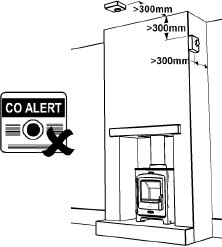

|
|
|
|
CARBON MONOXIDE WHAT CARBON MONOXIDE IS Carbon monoxide (CO) is a colorless, odorless, and tasteless gas that is slightly less dense than air. ALL solid fuel appliances produce potentially fatal concentrations of carbon monoxide into the chimney, even when they are working correctly, and even if burning smokeless fuels. Most solid fuels consist substantially of carbon, which burns by combining with oxygen in the air in the ratio two atoms of oxygen to one atom of carbon to produce heat + carbon dioxide (CO2) gas. However, if the mix of fuel and air is not quite right (not 'stoichiometric'), especially if there is too little air, a gas with not two, but only one part oxygen will be produced. This is, in fact, what happens much of the time, the gas produced is carbon monoxide (CO). CO combines with haemoglobin in the blood in just the same way as the body expects oxygen to do, but it doesn't decombine when the blood meets body tissue. In this way CO damages the whole body. SYMPTOMS of POISONING CO cannot be seen, smelled or tasted and can be fatal. Indications of CO poisoning include symptoms similar to flu, but with no fever.  Symptoms of CO poisoning See also: NHS Website INSTALLERS SHOULD... ● Be scrupulous in ensuring that with every solid fuel installation; ● There is an adequate supply of fresh air to the appliance ● The whole chimney is appropriate, with adequate provision for cleaning ● The user is instructed in the correct use of the appliance ● A CO alarm is fitted  CO ALARMS The alarm should be the sort with a long-life built-in battery and a battery failure warning, conforming to EN 50291. A CO alarm is not the same thing as a smoke alarm, and a CO alarm will not necessarily give warning of fire. The type of CO 'patch' indicator with a spot which changes colour is of no warning value, especially as dangerous CO emission can often occur at night. The alarm needs siting with care, away from 'dead space' where no air circulates. Different makes and model of alarm need treating differently and the manufacturers instructions should be carefully followed. In the absence of specific instructions, a suitable location might be: ● Well above the appliance and within 3m of it ● At least 300mm from any internal corner of a wall or ceiling. ● Where it will not be damaged by heat. USERS SHOULD... ...protect themselves against the risk of CO poisoning by: ● Using solid fuel appliances correctly ● Making sure that air supply grilles etc are not blocked ● Never using barbecues indoors or in a confined space ● Checking the flueways inside a stove for blockage at least monthly ● Having the chimney swept at least annually, more often if smoky fuels are used. ● Maintaining and observing a CO alarm. |
|
MORE FROM Soliftec... Home ● Fuel Costs ● Installation ● Library ● About ● Air Supply ● Blogspot ● Building Rules ● Carbon Monoxide ● CE Marking ● Dictionary ● Efficiency ● Electricity - CHP ● Embodied Energy ● Fascinating Facts ● Fireplace Doctor ● Fuel Properties ● Heat Need ● Heroes ● Legislation ● Manufacturers ● Open Fires ● Smoke ● Solid Fuels ● Standards ● Statistics ● Stove History ● Tables, Data and Formulas ● Test Laboratories ● Thatched Roofs ● The Carbon Cycle ● The Chimney Effect ● Wood Fuel ● Email: info@soliftec.com COPYRIGHT and ALL RIGHTS RESERVED: © Soliftec Ltd, Thursday 19 December 2019 BUILT WITH WHIMBERRY matrixstats |